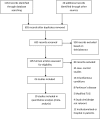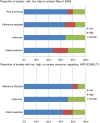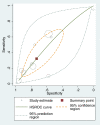Is the Timed Up and Go test a useful predictor of risk of falls in community dwelling older adults: a systematic review and meta-analysis
- PMID: 24484314
- PMCID: PMC3924230
- DOI: 10.1186/1471-2318-14-14
Is the Timed Up and Go test a useful predictor of risk of falls in community dwelling older adults: a systematic review and meta-analysis
Abstract
Background: The Timed Up and Go test (TUG) is a commonly used screening tool to assist clinicians to identify patients at risk of falling. The purpose of this systematic review and meta-analysis is to determine the overall predictive value of the TUG in community-dwelling older adults.
Methods: A literature search was performed to identify all studies that validated the TUG test. The methodological quality of the selected studies was assessed using the QUADAS-2 tool, a validated tool for the quality assessment of diagnostic accuracy studies. A TUG score of ≥13.5 seconds was used to identify individuals at higher risk of falling. All included studies were combined using a bivariate random effects model to generate pooled estimates of sensitivity and specificity at ≥13.5 seconds. Heterogeneity was assessed using the variance of logit transformed sensitivity and specificity.
Results: Twenty-five studies were included in the systematic review and 10 studies were included in meta-analysis. The TUG test was found to be more useful at ruling in rather than ruling out falls in individuals classified as high risk (>13.5 sec), with a higher pooled specificity (0.74, 95% CI 0.52-0.88) than sensitivity (0.31, 95% CI 0.13-0.57). Logistic regression analysis indicated that the TUG score is not a significant predictor of falls (OR = 1.01, 95% CI 1.00-1.02, p = 0.05).
Conclusion: The Timed Up and Go test has limited ability to predict falls in community dwelling elderly and should not be used in isolation to identify individuals at high risk of falls in this setting.
Figures




References
Publication types
MeSH terms
LinkOut - more resources
Full Text Sources
Other Literature Sources
Medical

